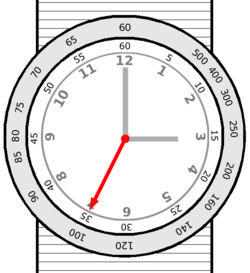How to use a divers bezel and tachymeter
Many iconic watches, such as the Rolex Submariner and Breitling Navitimer are created as tools, aimed specifically at a target audience as well as the general population. They provide more then just a measurement of time, here I try and explain how a divers bezel and tachymeter can be used.
Divers Bezel
 |
| Rolex Submariner |
This feature, included on the Rolex Submariner (pictured left) was created for divers using an oxygen tank. The uni-directional bezel (only turns in a single direction) includes clearly visible numbers indicating minutes passed. No numbers are included on the watch face to increase the ease of reading the bezel underwater.
Just before the wearer enters the water, the bezel would be rotated so that the marker that was at the 12 o'clock position now alines with the minute hand. By looking solely at the bezel this then shows the user how many minutes underwater they have been and when they need to surface. If we use the picture on the left as an example, the triangular marker at the 12 o'clock position would be rotated to the 2 o'clock position.
Divers bezels, as mentioned before, only rotate anti-clockwise in a uni-directional manner. This is a safety feature designed specifically to prevent the bezel from being knocked and moving clockwise, thus decreasing the time the user believes they have been underwater, risking the possibility of an oxygen shortage.
Tachymeter
 A tachymeter provides a scale of numbers around the outside of the watch face and bezel and is used to work out speed and distance traveled.
A tachymeter provides a scale of numbers around the outside of the watch face and bezel and is used to work out speed and distance traveled.
Speed
A formula is used to calculate the tachymeter reading when calculating speed.
T = 3600
t
T = tachymeter
t = time in seconds for event to occur
3600 = number of seconds per hour
For example, if you are traveling on a road with signs every mile but don't know the speed you are traveling - time the distance between each sign. If we use the picture above as an example, the time it took for the vehicle to travel 1 mile was 35 seconds, as indicated by the middle scale of numbers, the outer most scale will then indicate the speed in mph traveled, in this case, 100mph. The same would apply to measuring kilometers, if it took 35 seconds to travel a kilometer, the outer scale of number would indicate a speed of 100kph.
Distance
To calculate distance a constant speed must be held. The tachymeter scale is to be rotated to the position of the second hand at the time the measurement begins, once the second hand aligns with the corresponding speed of the vehicle, one unit of distance (mph/kph) has been traveled.
For example, if we use the same picture as before - if the constant speed is 100kph (or 100mph), when the second hand reaches '100' on the tachymeter the amount of time passed is 35 seconds and a single kilometer (or mile) will have been covered
Below is a great video I found explaining visually how to use these functions on a tachymeter.
No comments:
Post a Comment